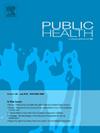Effect of working hours and shift work on preterm birth among Australian women in paid work during pregnancy: Prospective cohort study
IF 3.9
3区 医学
Q1 PUBLIC, ENVIRONMENTAL & OCCUPATIONAL HEALTH
引用次数: 0
Abstract
Objective
In Australia, the rate of preterm births increased from 8.3 % in 2010 to 8.7 % in 2021, posing risks not only during pregnancy and the neonatal period but also for long-term offspring development. While global studies highlight predictors of preterm birth, limited research explores the link between working conditions, such as long working hours, shift work, and preterm birth in Australian women.
Study design
Prospective cohort study.
Methods
This study analysed data from the Australian Longitudinal Study on Women's Health, including 2241 employed women who reported 2522 singleton births between 1996 and 2018. Mixed-effects logistic regression was used to account for repeated births from the same women. Data analysis was performed using STATA version 17.
Results
Long working hours were initially associated with an increased risk of pre-term birth (AOR 1.61, 95 % CI: 1.02–2.55), but this association became non-significant after adjusting for obstetric and health factors (AOR 1.21, 95 % CI: 0.76–1.92). Similarly, shift work showed no significant association with preterm birth (AOR 0.59, 95 % CI: 0.31–1.13). Low educational status (AOR 1.86, 95 % CI: 1.04–3.31), smoking (AOR 2.48, 95 % CI: 1.17–5.25), gestational hypertension (AOR 2.75, 95 % CI: 1.32–5.23), primiparity (AOR 2.02, 95 % CI: 1.13–3.63), asthma history (AOR 2.01, 95 % CI: 1.05–3.84) and lack of private health insurance (AOR 1.86, 95 % CI: 1.14–3.05) remained significantly associated with higher odds of preterm birth.
Conclusion
This study initially found a link between working over 40 hours per week and preterm birth, but this association was nullified after adjusting for health and obstetric factors. Additionally, shift work showed no significant association with preterm birth. Low educational status, smoking, gestational hypertension, asthma, primiparity, and lack of private health insurance were significantly associated with preterm birth. Addressing chronic diseases and social inequalities is crucial to reducing preterm birth rates.
工作时间和轮班对澳大利亚孕期有薪工作妇女早产的影响:前瞻性队列研究
在澳大利亚,早产率从2010年的8.3%上升到2021年的8.7%,不仅对怀孕和新生儿时期构成风险,而且对后代的长期发育构成风险。虽然全球研究强调了早产的预测因素,但有限的研究探讨了工作条件(如长时间工作、轮班工作)与澳大利亚妇女早产之间的联系。研究设计前瞻性队列研究。本研究分析了澳大利亚妇女健康纵向研究的数据,其中包括1996年至2018年期间报告2522例单胎分娩的2241名就业妇女。混合效应逻辑回归用于解释同一女性的重复生育。使用STATA version 17进行数据分析。结果长时间工作最初与早产风险增加相关(AOR 1.61, 95% CI: 1.02-2.55),但在调整了产科和健康因素后,这种关联变得不显著(AOR 1.21, 95% CI: 0.76-1.92)。同样,轮班工作与早产没有显著关联(AOR 0.59, 95% CI: 0.31-1.13)。低教育程度(AOR 1.86, 95% CI: 1.04-3.31)、吸烟(AOR 2.48, 95% CI: 1.17-5.25)、妊娠期高血压(AOR 2.75, 95% CI: 1.32-5.23)、初产(AOR 2.02, 95% CI: 1.13-3.63)、哮喘史(AOR 2.01, 95% CI: 1.05-3.84)和缺乏私人医疗保险(AOR 1.86, 95% CI: 1.14-3.05)仍与早产的高几率显著相关。这项研究最初发现了每周工作超过40小时与早产之间的联系,但在调整了健康和产科因素后,这种联系被取消了。此外,轮班工作与早产没有显著关联。受教育程度低、吸烟、妊娠高血压、哮喘、初产和缺乏私人医疗保险与早产显著相关。解决慢性病和社会不平等问题对于降低早产率至关重要。
本文章由计算机程序翻译,如有差异,请以英文原文为准。
求助全文
约1分钟内获得全文
求助全文
来源期刊

Public Health
医学-公共卫生、环境卫生与职业卫生
CiteScore
7.60
自引率
0.00%
发文量
280
审稿时长
37 days
期刊介绍:
Public Health is an international, multidisciplinary peer-reviewed journal. It publishes original papers, reviews and short reports on all aspects of the science, philosophy, and practice of public health.
 求助内容:
求助内容: 应助结果提醒方式:
应助结果提醒方式:


